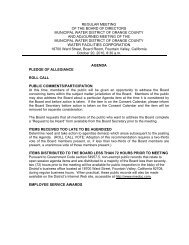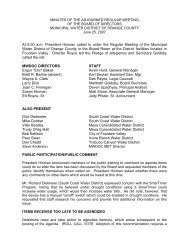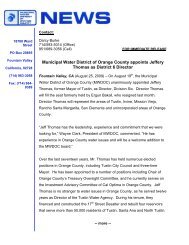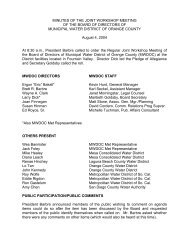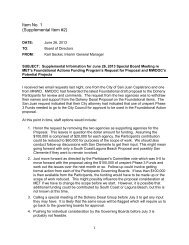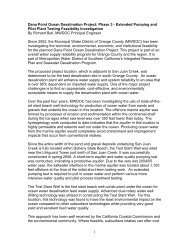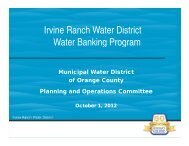UWM Plan - Municipal Water District of Orange County
UWM Plan - Municipal Water District of Orange County
UWM Plan - Municipal Water District of Orange County
You also want an ePaper? Increase the reach of your titles
YUMPU automatically turns print PDFs into web optimized ePapers that Google loves.
water at the retail level. The prorated amount <strong>of</strong> allocation is referred to as the Retail<br />
Impact Adjustment Allocation. For agencies that are 100 percent dependent on<br />
MWDOC, this method will result in an allocation <strong>of</strong> MWDOC supplies that, at the retail<br />
level, will result in a shortage equal to the Regional Shortage Percentage. This<br />
adjustment is only applied when the regional shortage levels are 15 percent (level 3) or<br />
greater. Table 4.3 below illustrated the maximum adjustment an agency may receive<br />
according to the regional shortage level.<br />
Table 4.3<br />
Retail Impact Adjustment<br />
Regional<br />
Shortage<br />
Level<br />
Regional<br />
Shortage<br />
Percentage<br />
Retail<br />
Impact<br />
Adjustment<br />
Maximum<br />
1 5% 0.0%<br />
2 10% 0.0%<br />
3 15% 7.5%<br />
4 20% 10.0%<br />
5 25% 12.5%<br />
6 30% 15.0%<br />
7 35% 17.5%<br />
8 40% 20.0%<br />
9 45% 22.5%<br />
10 50% 25.0%<br />
Unfortunately, the Retail Impact Adjustment MWDOC receives from MET may be less<br />
than the total retail impact adjustment for its client agencies. To mitigate this difference,<br />
MWDOC decreased each client agency’s retail impact adjustment according to their<br />
prorated share. However, in doing so the model ensures that no MWDOC client agency<br />
falls below the Wholesale Minimum Allocation Percentage Level, as illustrated in Table<br />
4.2.<br />
Conservation Demand Hardening Credit: The Conservation Demand Hardening Credit is<br />
used to address the increased difficulty in achieving additional water savings at the retail<br />
level due to implementation <strong>of</strong> conservation. The credit is calculated by multiplying an<br />
agency’s quantified conservation savings (in acre-feet) by its estimated retail shortage<br />
percentage prior to applying the credit. Each agency’s quantified conservation savings is<br />
calculated from a combination <strong>of</strong> the following categories:<br />
• Active Conservation – The water savings from <strong>Water</strong>-Use Efficiency devices<br />
according to the most recent year data available (year 2006 is currently used<br />
within the model). MWDOC’s database determines the amount <strong>of</strong> active<br />
conservation each client agency has saved.<br />
• Passive Conservation – The water savings from code-based savings in new<br />
development and natural replacement <strong>of</strong> devices. A two-part calculation was<br />
used to determine each client agency’s passive conservation savings. New<br />
development savings were determined by calculating the increase in retail<br />
service connections within each client agency’s service area for the years 1993<br />
MWDOC <strong>Water</strong> Supply Allocation <strong>Plan</strong> Page 13



